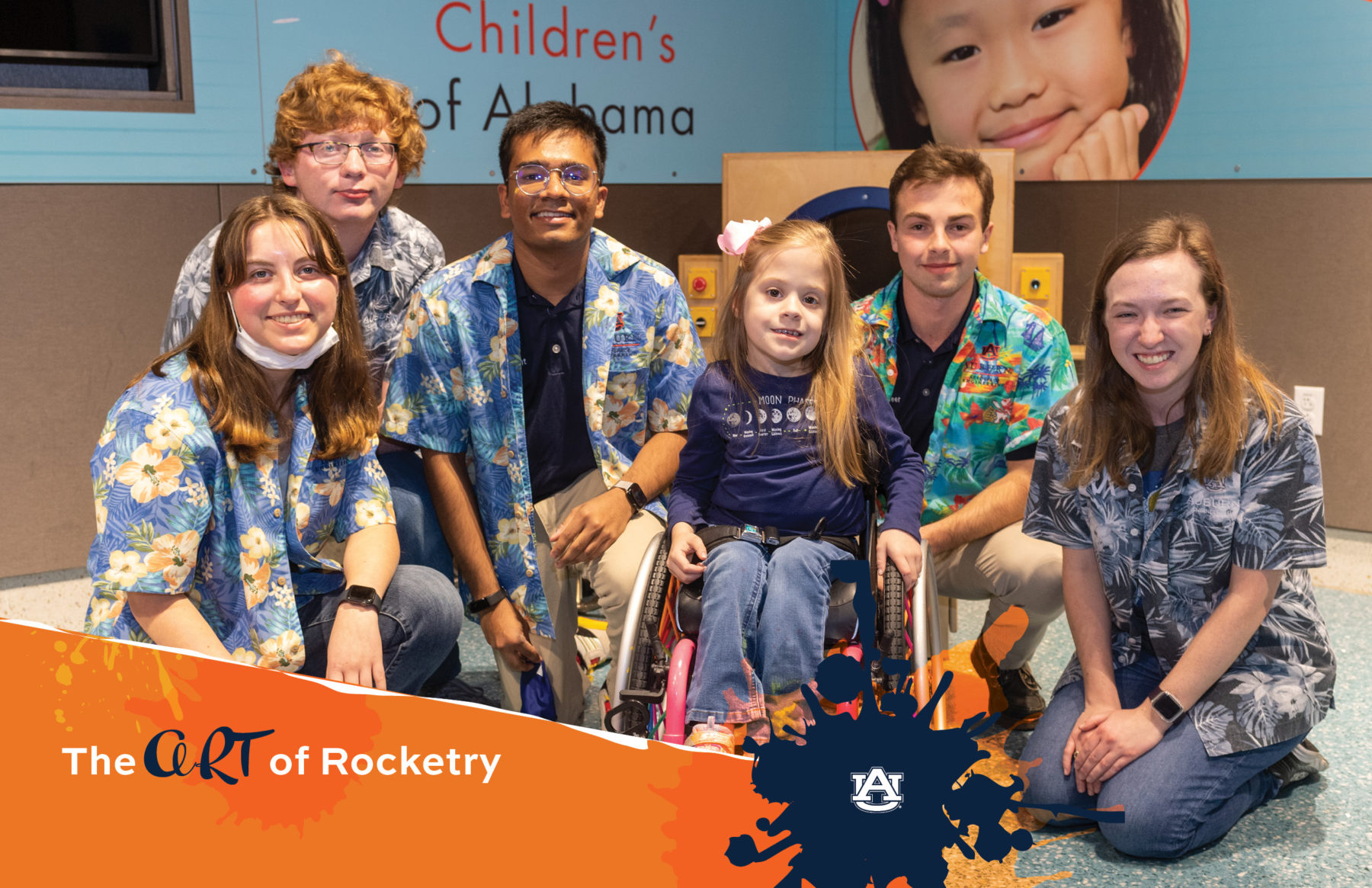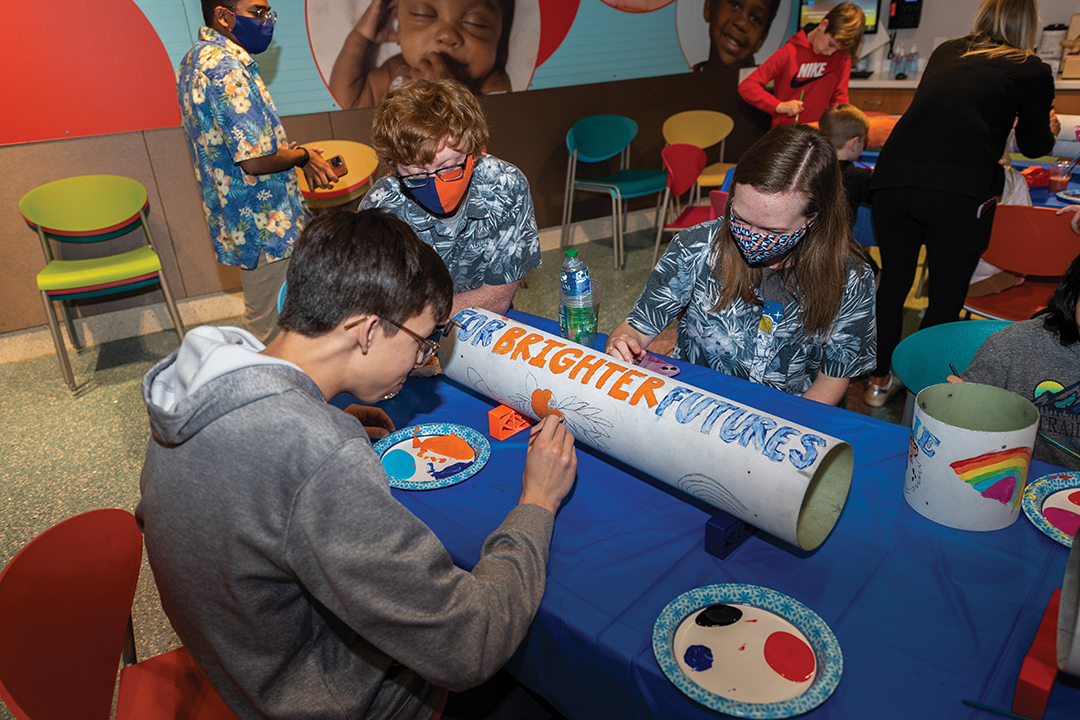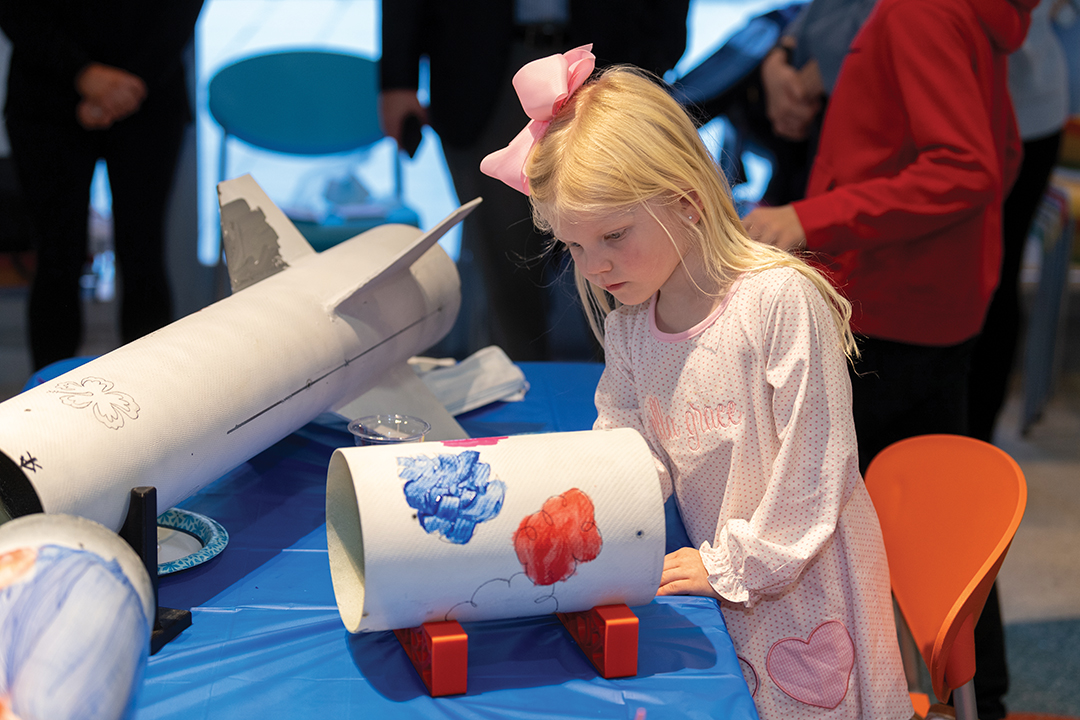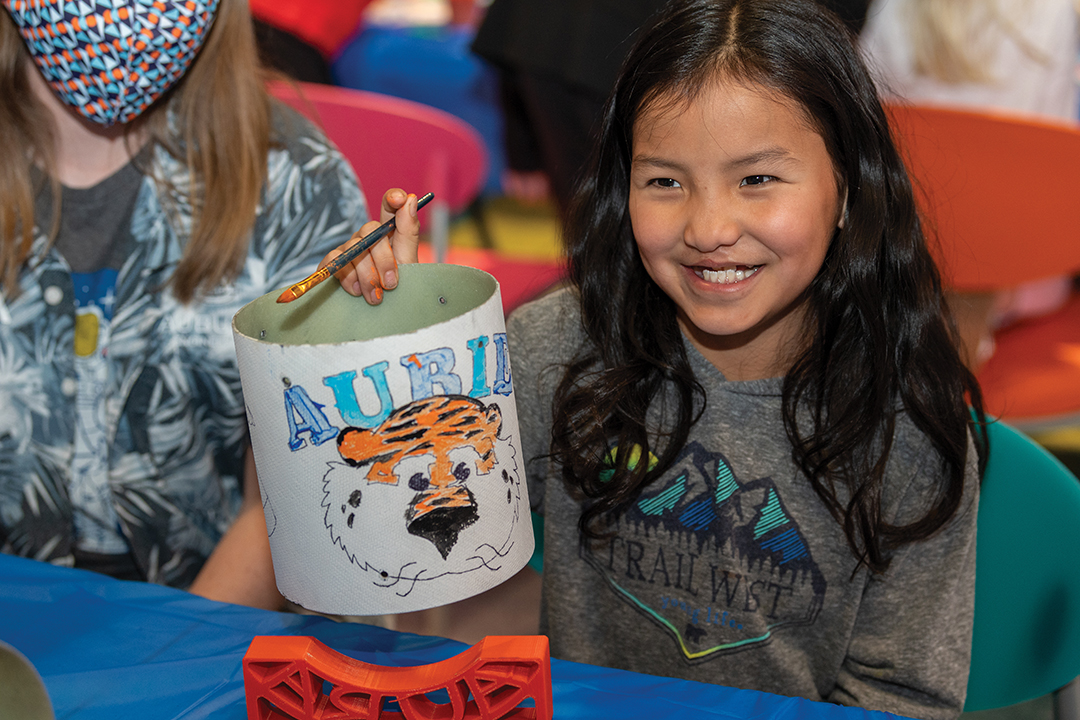
It didn’t resemble other rockets.
Instead, it was much better.
Adorned with water-colored tigers, astronauts, palm trees and sun bursts painted along the 11-foot-6-inch projectile’s fuselage and wings, the Auburn University Rocketry Association’s (AURA) entry into the NASA University Student Launch Initiative (USLI) competition April 12-17 in Huntsville, featured a handful of special artists.
A team of young patients — with guidance from select AURA members decked out in traditional “game day” Hawaiian shirts — spent the afternoon of Feb. 13 at Children’s of Alabama decorating the high-powered rocket with a special collection of personalities, imagination and style.
“I wish I could shrink myself and go inside the rocket,” said Cole Murphy, a 7-year-old ‘Children’s of Alabama Miracle Kid’ who was diagnosed with acute lymphoblastic leukemia when he was 3 and completed his treatment at the downtown Birmingham hospital in May 2022. “I’d like to be an astronaut and go into space because they have maps. But I might get lost in space, so that would be scary.”
In alignment with the hospital’s “For Brighter Futures” campaign, AURA President Preet Shah, a senior in aerospace engineering, beamed about teaming with Children’s of Alabama, where they can make a small difference.
“Outreach projects such as this give us the opportunity to be kids again,” Shah said. “As we go through engineering studies, there can be a lot of pressure and we sometimes forget how to enjoy ourselves with the little things in life. Here, interacting with and watching these kids makes us happy. Though many of these children have suffered, and the parents have suffered with them, we are confident that with the team and staff at Children’s of Alabama, they have brighter futures.”
Children’s of Alabama, a private, non-profit facility, is the only free-standing medical center in Alabama dedicated to treatment and care of children. Located in the heart of downtown Birmingham, Children’s of Alabama had more than 694,161 patient visits and 16,074 patient admissions in 2022.
Charlie Ann Shepherd, coordinator of Community Development at Children’s, watched as AURA team members gathered paint for the kids and shared, some one-on-one, with patients how the rocket works.

“Look at these kids. They are having so much fun,” Shepherd said at the event. “When I think of them getting to be a part of something that’s going to fly for Auburn University and the rocketry association, they get the opportunity to tell the story of Children’s Hospital as it soars into the sky. That’s exciting for our children and for the students here working with them.”
Diagnosed with spina bifida in utero, 6-year-old Logan McCool spent the first 30 days of her life inside Children’s neonatal intensive care unit. Countless hours and years of physical therapy later, she is learning to walk in custom orthotics, plays with friends at school and dreams of becoming a veterinarian.
“Today was super special! I had a lot of fun at the paint party,” said the 2022 Local Children’s Miracle Network Hospitals Champion.
“I painted a rocket ship on the rocket ship, and that’s pretty funny. But hey, I just have to go with it,” McCool said with a laugh. “I painted the rocket ship green and yellow on the wings, and orange on the fire which makes it go into the sky.”
Brian Thurow, the W. Allen and Martha Reed Professor and chair of aerospace engineering, said AURA team members are “truly emblematic of the ideals Auburn Engineering strives to embody.”

“I am extremely proud of the entire AURA team and their participation in this project with Children’s of Alabama,” he said. “As stated in the Auburn Creed, ‘I believe in the human touch, which cultivates sympathy with my fellow men and mutual helpfulness and brings happiness for all.’ This is just as true for our engineering students as it is for any other students on campus. In addition to their noteworthy technical achievements, AURA has a long history of integrating outreach into their club activities.”
Part of Auburn University’s nationally ranked Samuel Ginn College of Engineering, AURA works to manage and connect students with all aspects of rocketry, including design, propulsion, payload, mission analysis and return to earth. Members gain significant hands-on experience, not only in launch vehicle design, but with NASA technical standards, documentation, budget and briefings, all of which are invaluable to a career in the aerospace industry. Through a variety of launch competitions, aerospace companies can acquire a fresh perspective with innovative ideas and research from student teams, which is imperative for America’s endeavors in deep space missions.
“Not everyone will wind up building rockets beyond college, but the teamwork that goes into it is an important aspect of our learning experience,” said Ignacio Castro, a senior in aerospace engineering and AURA’s chief engineer. “Professors, they come up to us and say, ‘This is what you’re going to encounter when you’re going to work on a team for a large company.’ We run into problems all the time that need to be resolved and we resolve them ourselves. There are many long nights in the lab, which can be somewhat stressful. But at the end of the day, we get the job done.

“Our team makes for great engineers. They have that real life, hands-on experience that employers want. You can show them something tangible. ‘Hey, look what I’m building. This is what I’ve been working on.’”
Shah said the team learns technical skills in the classrooms, but it has the opportunity to explore what they’ve learned even deeper by building and testing the rockets.
“You gain that insight into what you’re going to learn in class sometimes before you take the class,” he added.
At the NASA USLI competition, teams were assigned weeks of design proposals, interviews and inspection/milestone checks were highlighted by a day of competition that required teams to launch rockets between 4,000 and 6,000 feet.
Official results, based mainly on the design proposals, will not be released until June.
Prior to USLI, AURA – and 13 teams from peer institutions – were challenged March 24-26 at the Argonia (Kansas) Cup to launch a rocket 9,000 feet then drop a golf ball as close to a pre-determined target as possible. In other words, a 5-iron approach shot from the stratosphere.
How close did they come? Only one-fifth of a mile — closest to the pin.
“Argonia was one of our biggest learning experiences to this day,” Shah said. “We were one of only five teams to successfully ignite both stages. We had some issues, but our performances at USLI and Argonia are a validation for all of the hard work and hours we put into our program. The rocket we brought to NASA USLI in Huntsville was special. We might not have won the overall event, but those children are the real champions.”
Castro considered his afternoon at Children’s of Alabama, “by far the most fulfilling thing I’ve done in the four years that I’ve been part of this team.”
“Some of the kids we were collaborating with want to be engineers down the line,” Castro said. “I can’t think of a better way to get them even more inspired and see something exciting. You never know, some of these kids might be next-generation engineers.
“It’s always a special feeling knowing that something you worked on for hours, particularly in a team environment, soars into the sky and completes the tasks you designed it to complete. It’s even more rewarding knowing part of our creation is carrying special handiwork. I hope this is the beginning of a long-lasting partnership between AURA and Children’s of Alabama,” he added.